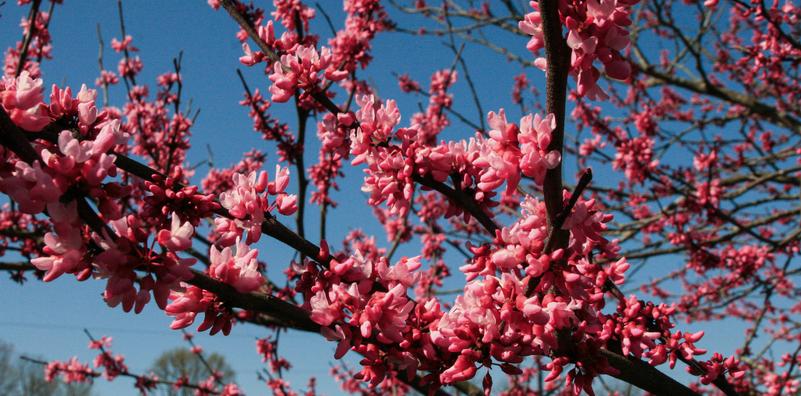The Hidden Magic of Redbuds
Last week, we covered a notorious garden volunteer, Viola soraria, a native groundcover with a sordid history that has some scratching their heads as to why we would even bother selling it (I make my argument here and will die on this hill). This week we’re taking the alternate route and telling you about quite the opposite - a small, native tree that, very genuinely, we have a hard time keeping in stock due to their popularity and covetousness. That’s right - of course, we’re talking about our native Eastern redbud, Cercis canadensis.
What hasn’t already been said about Cercis canadensis that you haven’t read one hundred times over? We know they’re Fabaceae family members, are well suited for a variety of cultural conditions, look absolutely fantastic blooming alongside their Cornus florida companions, and are generally one of the only small native shade trees we commonly see used as an ornamental in our local gardens. There’s more to these trees than our regularly used sources infer, though, what with their abundance of ethnobotanical uses and folkloric histories that have managed to get muddled by the amount of ecological and physiological information available. Let’s uncover the hidden treasures of Cercis canadensis.
While we know Cercis canadensis in our neck of the woods as Eastern redbud, their cousins in the far-eastern hemisphere are called Judas trees, and our native species occasionally shares this moniker as well. The true Judas tree is Cercis siliquastrum, a European native commonly found in the Mediterranean region, believed to be the tree that Judas Iscariot hanged himself from. Not a small feat for a tree that’s known for its rather weak branches! From this legend, it is said that his death caused the tree’s white flowers to turn red, eventually becoming the basis of identification for this genus. Surely, it is nothing more than pure coincidence that redbuds go into flower right in time for the Easter holiday! While Cercis siliquastrum is not hardy to our Mid-Atlantic climate, our native Cercis canadensis is a local symbol of this biblical tale and has sustained its reddish flower buds in solidarity with its Mediterranean kin.
If you remember from last week, I recommended that you nibble on some of your unwanted violet flowers instead of removing them from the landscape. Turns out redbud flowers are just as delicious and have been a favorite snack of children and whimsical adults for centuries. In Mexican cuisine and geographically in the region of the Mexican redbud, Cercis canadensis var. mexicana, the flowers are harvested and fried or pickled. Recipes exist for redbud flower vinegar, lemonade, tea, and even jelly, proving their versatility as a seasonal delicacy.
Make sure to leave some flowers for the bees, though, and boy, is there no shortage of bee species that make use of the blooms. Aside from the expected honeybees and bumblebees, Henry’s elfin butterflies, mason bees, long-horned bees, cuckoo bees, and various other solitary bee species rely on the early spring nectar from redbud blooms. The inevitable pollination results in peapod-shaped fruits, which are important forage for quails, bobwhites, grosbeaks, pheasants, songbirds, small mammals, and deer.
Part of what makes these flowers so unique is that they emerge directly from the bark, which holds its own strange and beautiful mysteries. This particular floral growth habit, called “cauliflory”, is more common in tropical species, thought to have evolved for pollinators like bats who climb up the trunks to the canopies of tropical fruit trees including jackfruit (Artocarpus heterophyllus) and durian (Durio zibethinus).
Our very own Cercis canadensis stands nearly alone among temperate trees as a caulifloriferous curiosity (not to be confused with the vegetable, but visually kinda the same deal, hence the name). Traditionally, indigenous peoples utilized the bark in tea form to treat maladies such as fevers and colds, and more specifically, whooping cough. Modern science has proven that oil extracted from Cercis canadensis bark contains major volatile compounds such as 1-hexanol, an antioxidant and anti-inflammatory compound found also in black tea and olive oil, which composed approximately 23% of the overall extract. Not that you’ll want to be cutting into your redbud wood anytime soon, considering they’re all the envy of native plant nerds who crave the early spring explosion of tightly bound blooms, and you’ll likely receive some flak from redbud-diehards.
See all our Woody Ornamentals


